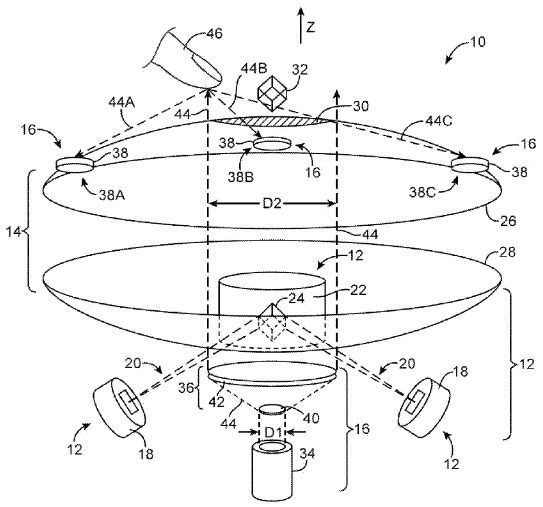About once a day I check out this blog’s access statistics, and specifically the search terms that brought viewers to it (that’s how I found out that I’m the authority on the Oculus Rift being garbage). It’s often surprising, and often leads to new (new to me, at least) discoveries. Following one such search term, today I learned that Apple was awarded a patent for interactive holographic display technology. Well, OK, strike that. Today I learned that, apparently, reading an article is not a necessary condition for reblogging it — Apple wasn’t awarded a patent, but a patent application that Apple filed 18 months ago was published recently, according to standard procedure.
But that aside, what’s in the patent? The main figure in the application (see Figure 1) should already clue you in, if you read my pair of posts about the thankfully failed Holovision Kickstarter project. It’s a volumetric display of some unspecified sort (maybe a non-linear crystal? Or, if that fails, a rotating 2D display? Or “other 3D display technology?” Sure, why be specific! It’s only a patent! I suggest adding “holomatter” or “mass effect field” to the list, just to be sure.), placed inside a double parabolic mirror to create a real image of the volumetric display floating in air above the display assembly. Or, in other words, Project Vermeer. Now, I’m not a patent lawyer, but how Apple continues to file patents on the patently trivial (rounded corners, anyone?), or some exact thing that was shown by Microsoft in 2011, about a year before Apple’s patent was filed, is beyond me.

Figure 1: Main image from Apple’s patent application, showing the unspecified 3D image source (24) located inside the double-parabolic mirror, and the real 3D image of same (32) floating above the mirror. There is also some unspecified optical sensor (16) that may or may not let the user interact with the real 3D image in some unspecified way.
But that aside, is this really a holographic display? Yes, yes it is. It is not based on lasers, mirrors, and interference, but it creates a free-floating, three-dimensional, real image, and that’s good enough for me. To be a bit more technical about it, the correct term would be “aerial image projection of a volumetric display,” but since that would elicit at most a “huh?” reaction from anyone who’s not an expert, and since the visible result lines up almost perfectly with what the general public imagines a hologram would be, we’ll let it slide (unlike some other stuff).
So why do I say this “almost perfectly” lines up with the public’s idea of holograms? Because the public’s idea of holograms has a few things wrong — just read the Holovision posts I linked in the second paragraph. Instead of reiterating that, let’s answer some questions that have already been asked, as convenient bullet points:
- Will this be the display for the next iPhone? Nope.
- Why not? Because, while this can create free-floating 3D images, those images can be at most as big as the 3D image source inside the double mirror. In other words, if you jam this entire thing into an iPhone, the maximum hologram size is about 1mm across, tops.
- How about the iPad? Ehhh, nope. Same reason.
- Next-generation TV, then? Maybe, but the parabolic mirrors need to be several times larger than the maximum 3D image size, or the optics don’t work. So if you want to have a 60″ holographic TV, get ready to install a 240″ (rough estimate) mirror dish in your living room. Oh, and you can only see the portion of the free-floating image that’s surrounded by your view of the hole in the top mirror (see next bullet), so you can only watch from above (if the mirrors lie flat as indicated), not from the side. Yeah, important little detail.
- Is this a holographic projector, as in “help me, Obi-Wan Kenobi?” Nope.
- Why not? Because those things are fiction.
- Is this cool? Oh yeah, it’s plenty cool. Especially when combined with 3D interaction, as presented here (and mentioned, but not shown, by Project Vermeer). It’s just neither new, nor is it what you might imagine it to be.
PS: reading the patent, it’s hilarious how those things can be ultra-vague and ultra-specific, but in a pointless way, at the same time. Exhibit 1: “display 12 may be a volumetric display such as a multiplanar or rotating panel display, a holographic display, an integral imaging display, a re-imaging display, a parallax display, or other suitable display capable of displaying 3D images” (that’s vague; you sure you didn’t forget any potential real or fictional technology in that list?). Exhibit 2: “The input signal provided to mixer 56 over line 64 may be proportional to reflected optical signal 44′ and may take the form of the following sinusoidal signal: sin(.omega..sub.LOt+.phi.) (1)” (wow, I’m blinded with poorly type-set math, but since mixer 56 and line 64 may or may not exist, what’s the point?). I seem to remember that patents were supposed to protect a specific implementation of an idea, not a fuzzy general notion of some idea that might or might not ever be implemented. But I guess that’s why I wouldn’t pass the patent bar.


I once heard that in some jurisdiction, you’re actually more protected against lawsuits if they can’t prove you knew others had patented an idea before you; or in other words, in some places it’s actually good for you if you don’t check if someone else came up with the idea before claiming it’s yours.
Pingback: Here we go again with Apple’s holography patent | Doc-Ok.org